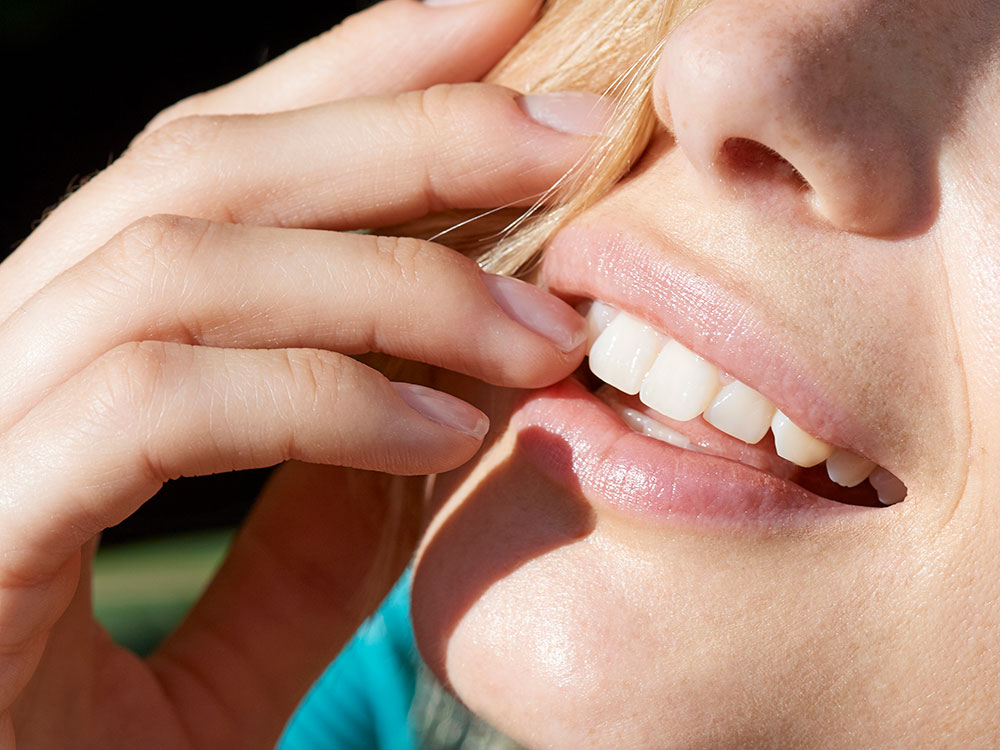There are a ton of reasons why teeth can shift: Genetics, age, grinding, bad habits, cavities, sleeping on your side, and even ignoring that decades-old retainer staring back at you in your medicine cabinet are all considered culprits. Luckily, if you can identify early on what is causing the “shift,” you may be able to prevent it from getting worse and save your smile in the process.
“New technology has created so many painless ways of straightening your teeth—and they can be done in a few months to a year for so many patients,” Atlanta cosmetic dentist Ronald Goldstein, DDS says. “More complicated problems can take longer.”
You May Also Like: Why Botox Is a Fast and Easy Way to Fix a Gummy Smile Without Surgery
Genetics
The bad news: There are some things that are totally out of our control, and that includes the smile category. “Even if you are born with straight teeth, if your genes dictate that they will shift at some point, they will,” says New York orthodontist Jacqueline I. Fulop-Goodling, DMD.
Cavities
When cavities are filled, the composite (plastic) can cause changes to your teeth and occasionally your bite. If decay is not treated, it can spread to the gums and bone, eating away the bone that holds the teeth in place, and loosening them.
Age
New York cosmetic dentist Steven E. Roth, DMD says that, as we age, the area between the teeth starts to wear away. “As this happens, the enamel thins out. And, because the lower teeth are inherently thinner, they wear out faster,” he says. The more wear and tear on the lower teeth, the less able they are to withstand the force of the top teeth when biting down, causing shifting.
Grinding
Grinding forces the lower jaw forward and puts tension on the upper teeth. The continual thrusting affects the position of the upper arch, pushing it out of alignment. Dr. Goldstein warns all his patients of the other dangers of grinding your teeth, such as wearing off the biting edges of your teeth, causing an older look, plus possible head and muscle aches.
Tooth Loss
“If a tooth is missing on the bottom, the tooth above it will grow downward since there is nothing there to stop it, and vice versa. Likewise, the teeth next to it will start to move sideways, too,” says Chevy Chase, MD prosthodontist Youssef Obeid, DDS.
Periodontal Disease
The supporting bone around the tooth ligament that encases your tooth helps to hold your teeth in place. “With improper oral care at home, failure to have regular tooth cleanings, gum disease, traumatic occlusion, and possibly genetic predisposition, you could have periodontal disease, which can weaken or even destroy the surrounding bone,” Dr. Goldstein warns. “The ‘bottom line’ can be loosening of the teeth or tooth mobility, resulting in teeth shifting. However, even if you have the above, there is effective treatment to cure the disease and even replace the teeth back into their position—but the best bet is to prevent it from happening! I recommend our patients come in for prophylaxis [tooth cleaning] and dental checks at least every six months. The very best way to help stop any disease is to see the hygienist every four months and have your dentist or hygienist set up a specific oral care program just for you.”
Tongue Thrust
If you have a habit of pushing your tongue against your upper/lower teeth when you swallow, you have what is known as ‘tongue thrust.’ “This may well be a leftover habit from childhood, but it could also be a result of chronic allergies, stress, swollen tonsils or adenoids,” Dr. Goldstein explains, and adds that the habit can also occur during sleep. “Problem is, when left unchecked, your teeth can move forward, creating spaces between them and even an ‘open bite.’ So this habit can be the cause of ‘forced’ tooth shifting. The good news is an orthodontic appliance can be made to temporarily halt the problem.”
Not Wearing Retainers
Even if you’re years out from the last time you wore braces, there IS a reason you have that retainer! “One of the most frequently seen causes of crowded or spaced teeth in adults who have had previously straight teeth from orthodontic treatment is not adhering to wearing a retainer after treatment or stopping wearing it altogether,” Dr. Goldstein says. “A constant reply from the crowded or spaced-teeth patient is, ‘I thought I had worn it enough and the teeth were straight.’ My advice to patients who are given a retainer to wear at night is to continue to wear it if you want your teeth to remain straight. If you want to test how your teeth are doing, take it out for one night. Then, the next night, put it in and if it is tighter, that means your teeth are starting to move slightly and you need to continue to wear your retainer. Only your retainer knows for sure! Also, visit with your general dentist or orthodontist to check.”

















